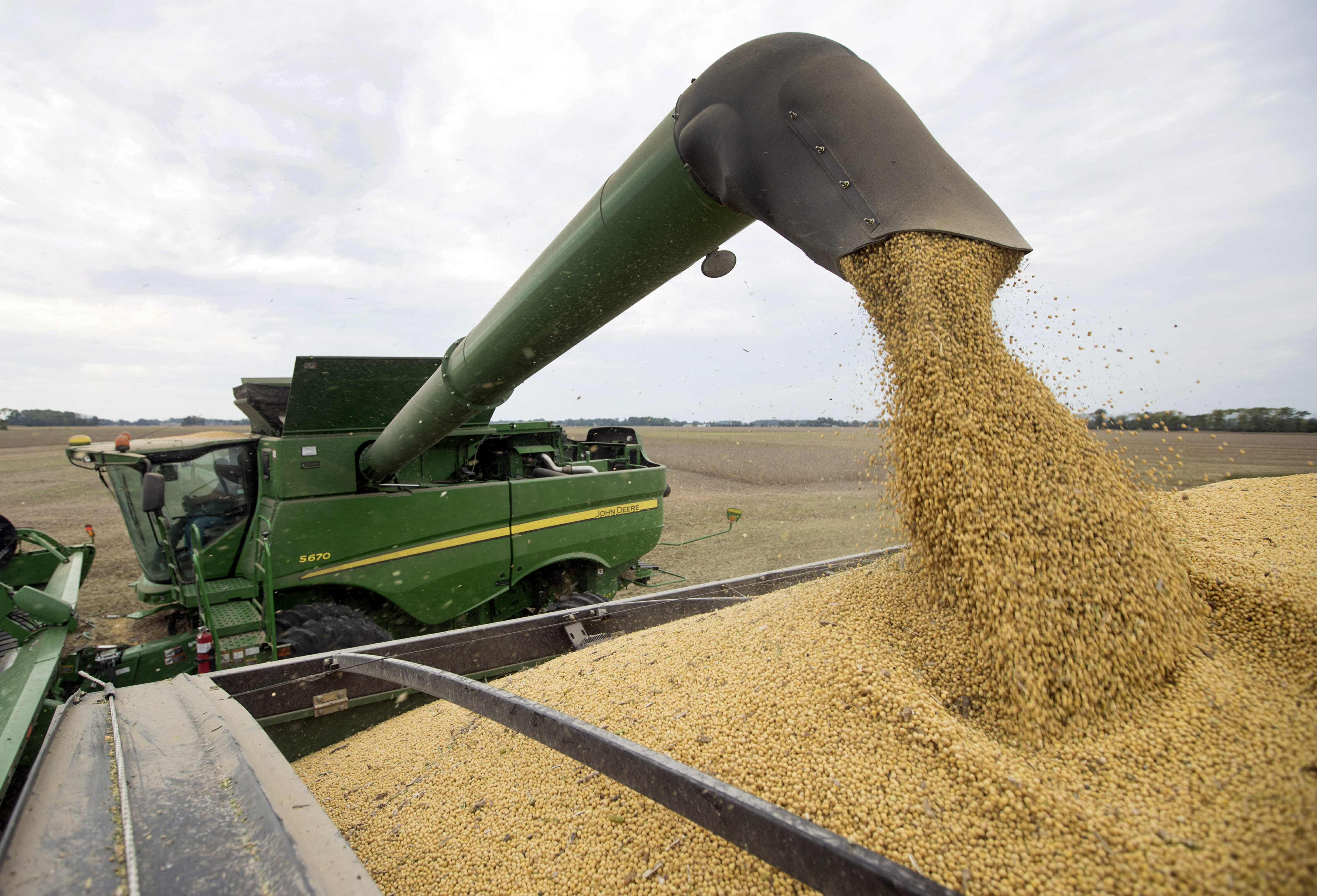
Escalating trade war causing anxiety in America's heartland
BISMARCK, N.D. (AP) — When President Donald Trump began talking about tariffs in 2017, Upper Midwest soybean farmer Jamie Beyer suspected that her crop could become a weapon. Two years later, she and her family are watching the commodity markets on an hourly basis as an escalating trade war between the U.S. and China creates turmoil in rural America.
“It’s hard to concentrate on planting when you’re constantly checking your phone to see if another (Trump) tweet has prompted a dip in the market,” said Beyer, of Wheaton, Minnesota. Beyer’s family farms about 3,500 acres in Minnesota and South Dakota and she figures it has lost about $230,000 because of the trade war.
These are days of “a little bit of panic” among farmers, she said, and the anxiety is spreading to the agricultural lending industry. One economist said the farm sector might face its greatest downturn in three decades.
Soybean prices plunged early this week to a 10-year low after Trump’s decision late last week to impose punitive duties on $200 billion of imports from China and China’s retaliatory tariff hikes Monday on $60 billion of American goods. U.S. officials then listed $300 billion more of Chinese goods for possible tariff hikes, and China on Tuesday vowed to “fight to the finish.”
The trade war that began last summer has already hurt farmers, despite $11 billion in relief payments that were doled out last year by the federal government. The personal income of farmers declined by $11.8 billion through the first three months of 2019, according to the U.S. Commerce Department. A similar pace of decline is expected in the coming months, according to the Federal Reserve Bank of Kansas City.
“The domestic stress caused by the administration’s trade policy is nowhere more evident than in the agricultural sector,” said Joseph Brusuelas, chief economist at the consultant RSM. “Should the current policy pathway not be changed, the farm sector is going to experience the greatest downturn since the late 1980s, driven by widespread bankruptcies and consolidation.”
During the farm credit crisis of the 1980s, high interest rates and falling land prices led to widespread farm foreclosures. One positive difference now is that land and farm asset values have been holding their own, and “overall, farm balance sheets look pretty good,” said Kent Thiesse, senior vice president and farm management analyst at MinnStar Bank in Lake Crystal, Minnesota.
But working capital is becoming a problem, as the trade war comes after recent poor crop years in some areas. Most farmers were able to get financing to plant a crop this spring, thanks in part to the federal relief payments, but “if there’s no government assistance this year we’re going to be looking at some serious losses by fall,” Thiesse said.
Trump said Monday that more aid is planned. U.S. Sen. John Hoeven, a North Dakota Republican who heads the Senate Agriculture Appropriations Committee, put the estimated amount at $15 billion.
That could be key to some farmers. In southern Minnesota, for example, soybeans for fall delivery are bringing a price of about $7.50 per bushel, about $2 lower than a year ago and about $1 lower than the break-even price.
“A lot of farmers say they’re not getting too excited to go out and plant soybeans because you’re probably guaranteeing yourself a loss when you put them in the ground,” Thiesse said.
The trade war is also affecting other crops, such as corn, as well as other industries, such as livestock and steel, from which farm equipment is made.
“Everything that I need to run my business or supply my business is going up,” said Randy Richards, who farms near Hope, North Dakota. “What I have to sell is going down.”
Bob Metz, a fifth-generation farmer from northeastern South Dakota, said he’s been talking to business owners in small towns and “they are suffering up and down Main Street. The farmers don’t have any extra cash to come to town and buy a TV or a couch or go out to dinner in the evening.”
The American Soybean Association said it supports Trump’s overall goals, but that it “cannot support continuing and escalating the use of tariffs to achieve them.”
“The soybean market in China took us more than 40 years to build, and as this confrontation continues, it will become increasingly difficult to recover,” said American Soybean Association President Davie Stevens, who farms soybeans in Kentucky. “With depressed prices and unsold stocks expected to double by the 2019 harvest, soybean farmers are not willing to be collateral damage in an endless tariff war.”
Soybean prices rose a bit on Tuesday, and Beyer, the Upper Midwest farmer, said “it’s a bit of a roller coaster.”
However, “Yesterday I was mad,” she said. “Farm families are doing their job. They’re getting the fields planted where they can, but it just seems like the policy makers are behind the ball on all this stuff. Announcing the tariffs and not having a plan for American farmers is just not the right way to do things.”
___
Associated Press writers Dave Kolpack in Fargo, North Dakota, and Doug Glass in Minneapolis contributed to this story.
The Western Journal has not reviewed this Associated Press story prior to publication. Therefore, it may contain editorial bias or may in some other way not meet our normal editorial standards. It is provided to our readers as a service from The Western Journal.
Truth and Accuracy
We are committed to truth and accuracy in all of our journalism. Read our editorial standards.
Advertise with The Western Journal and reach millions of highly engaged readers, while supporting our work. Advertise Today.












